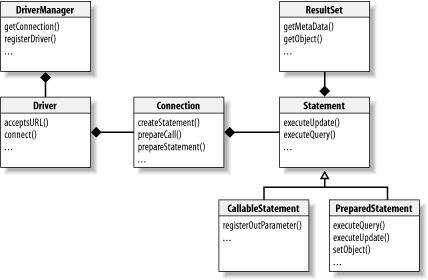JDBC Basics
The JDBC API is a set of classes and interfaces that allows a Java application to send SQL statements to a database in a vendor-independent way. The API consists mostly of interfaces that define the methods you use in your program. Database engine vendors and third parties provide implementations of these interfaces for a specific database engine; such an implementation is called a JDBC driver. This allows you to develop your program in a database-independent way and connect to a specific database engine by plugging in the appropriate JDBC driver at deployment time. There are JDBC drivers for most database engines on the market, both commercial and open source. If you can’t get one from your vendor, check out Sun’s list of third-party drivers at http://industry.java.sun.com/products/jdbc/drivers.
Figure 24-1 shows how the main interfaces and classes are related.
 |
All JDBC core classes and
interfaces
belong to the java.sql package. Of the types shown
in Figure 24-1, only the
DriverManager is a class (part of the standard
J2SE package); the rest are interfaces implemented by each unique
JDBC driver.
The Driver implementation is the entry point to
all the other interface implementations. When the
Driver is loaded, it register
itself with
the DriverManager. When the JDBC application needs a connection to a database, it asks the ...
Get JavaServer Pages, 3rd Edition now with the O’Reilly learning platform.
O’Reilly members experience books, live events, courses curated by job role, and more from O’Reilly and nearly 200 top publishers.

